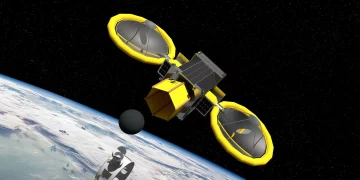In recent years, the space industry has undergone a significant transformation, largely driven by private companies seeking to capitalize on the potential of space for research, tourism, and commercial activities. The prospect of private space stations, orbiting laboratories dedicated to scientific research and private enterprises, is one of the most exciting developments in this new era of space exploration. These space stations aim to supplement or replace the aging International Space Station (ISS) while paving the way for new business models and opportunities in low Earth orbit (LEO).
This article explores how private companies are working on building space stations for both research and tourism, the potential benefits, and the challenges involved in creating these new orbital facilities.
1. The Changing Landscape of Space Stations
Historically, space stations were the domain of government space agencies. The International Space Station (ISS), launched in 1998 and operated by a consortium of NASA, Roscosmos, ESA, JAXA, and CSA, has been the centerpiece of human presence in space for over two decades. However, as the ISS nears the end of its operational lifespan, private companies have begun to show interest in taking over the baton. They are looking to develop their own space stations, transforming the way we live and work in orbit.
With the success of companies like SpaceX, Blue Origin, and Axiom Space, we are seeing a shift from public to private control in space activities, including orbital research and tourism. These companies envision a future where space stations are not just tools for scientific research but also platforms for commercial ventures, tourist experiences, and space-based manufacturing.
2. Private Companies in the Space Station Race
Several private companies are already making significant strides toward developing their own space stations. These companies are leveraging technological advancements, public-private partnerships, and the demand for space tourism to create viable business models that go beyond traditional space exploration.
1. Axiom Space
Axiom Space, founded in 2016, is one of the leaders in the race to build private space stations. Their vision is to create the world’s first commercial space station. Axiom Space is building a module that will initially be attached to the ISS. Over time, these modules will become a standalone station, allowing private astronauts, researchers, and tourists to visit and carry out a wide range of activities.
Axiom’s modules are designed to be adaptable, allowing for various applications ranging from research to entertainment. They are already providing private astronauts with the opportunity to visit the ISS, with plans to expand their offering by 2025. Axiom Space is also working with NASA to make their space station the next big hub for commercial space activities after the ISS.
2. Blue Origin – Orbital Reef
Blue Origin, founded by Amazon’s Jeff Bezos, is another major player in the private space station race. Blue Origin is working with Boeing, Redwire Space, and other partners on a space station concept called Orbital Reef. This ambitious project aims to create a mixed-use commercial space station that can host astronauts, researchers, and tourists in low Earth orbit.
Orbital Reef will serve as a research lab, industrial manufacturing site, and leisure destination. The station will feature an array of facilities, including laboratories, residential modules, and spaces for entertainment, aimed at fostering a sustainable low Earth orbit economy. Blue Origin plans to have Orbital Reef operational by the late 2020s, positioning it as a key asset for future space endeavors.
3. SpaceX – Starship and Commercial Missions
Though SpaceX has not specifically announced plans for a private space station, its Starship program and various commercial ventures have positioned the company as an influential player in the future of private space stations. Starship is expected to provide the heavy-lift capacity needed to transport large modules to orbit, which could be integral for space stations.
In addition to its ambitions to carry astronauts to the Moon and Mars, SpaceX could play a vital role in transporting crew and cargo to private stations like those being developed by Axiom and Blue Origin. Starship’s reusable capabilities and its ability to carry large payloads into orbit could be key to enabling sustainable, commercial space activities.
4. Sierra Nevada Corporation – Dream Chaser
Sierra Nevada Corporation (SNC) is developing the Dream Chaser spaceplane, which has the potential to become a key logistics vehicle for future private space stations. While Dream Chaser’s primary mission is to deliver cargo to the ISS, the spaceplane could also play a role in servicing new commercial space stations, transporting supplies and personnel.
SNC’s Dream Chaser is a unique spacecraft that can land on traditional runways, making it a versatile and cost-effective solution for transporting goods and people to and from private orbital stations.

3. The Role of Private Space Stations in Research and Tourism
Private space stations hold immense potential in two major sectors: scientific research and space tourism. These stations could offer unparalleled opportunities for groundbreaking experiments and provide a unique and exciting experience for tourists.
1. Advancements in Scientific Research
Private space stations will allow scientists to conduct research in a microgravity environment—something that is not easily achievable on Earth. With the retirement of the ISS on the horizon, the need for replacement or expansion of space-based research infrastructure is paramount.
In private space stations, research could focus on various fields, such as:
- Material Science: Studying the behavior of materials in space could lead to the development of new technologies, from better pharmaceuticals to advanced manufacturing techniques.
- Health and Medicine: Researchers will continue to study the effects of space travel on the human body, which could inform medical advancements on Earth and ensure astronauts remain healthy on longer missions to Mars.
- Agriculture: Understanding how plants grow in space is crucial for supporting long-term missions, such as establishing colonies on the Moon or Mars.
- Earth Observation: Private space stations may also provide an excellent vantage point for monitoring climate change, weather patterns, and other phenomena on Earth.
Unlike the ISS, which has strict guidelines and is run by governmental organizations, private space stations can provide greater flexibility in research priorities and faster turnarounds on experiments.
2. Space Tourism and Commercial Ventures
In addition to conducting research, private space stations are positioning themselves as destinations for space tourists. These tourists would be able to experience zero gravity, witness breathtaking views of Earth, and even stay for extended periods. Companies like Blue Origin and Virgin Galactic are already offering suborbital tourism, and a private space station offers the potential for longer stays and a more immersive experience.
The Orbital Reef project, for example, is specifically designed with space tourism in mind. It will feature luxury accommodations, as well as space for recreation and leisure activities, such as space walks and viewing Earth from orbit. This type of tourism is expected to grow as costs decrease and the technology becomes more accessible.
Besides tourism, private space stations could host corporate activities, such as:
- Product development: Companies could test products and materials in microgravity, opening up new business opportunities.
- Media: Private space stations could host film shoots or special events, offering unique and unprecedented opportunities for entertainment.
4. Challenges in Developing Private Space Stations
While the idea of private space stations is exciting, it comes with numerous challenges that must be addressed before these ventures can become a reality.
1. Cost and Funding
Building and maintaining a space station is an expensive endeavor. Even with the support of commercial interests and government contracts, the cost of developing a space station remains high. However, as technology advances and the space industry continues to grow, the costs of launching and operating these stations are expected to decrease over time, potentially making them more commercially viable.
2. Space Debris and Sustainability
Space debris is an ongoing concern for all space activities, and private space stations are no exception. As the number of satellites and space stations increases, so does the risk of collisions with debris. Developing systems to manage and reduce space debris will be critical to ensuring the safety of private stations and the longevity of the space environment.
3. International Regulations
Space stations, even private ones, operate in a shared environment. International agreements and regulations will be necessary to ensure that private space stations operate safely, respect the interests of other space-faring nations, and avoid conflict. Collaboration between governments and private companies will be essential to establish frameworks for responsible space station operations.
5. The Future of Private Space Stations
The future of private space stations looks promising, with increasing interest from both private companies and governments. These stations will likely play a key role in future space exploration, serving as hubs for scientific research, commercial ventures, and tourism.
As technology improves, costs decrease, and the space industry matures, private space stations could become as common as research laboratories and hotels on Earth. They could open up the frontier of space to a new generation of explorers, entrepreneurs, and tourists, pushing humanity closer to its goal of becoming a multi-planetary species.


















































Discussion about this post